 Abengoa
Abengoa
Annual Report 2011
- Activities
- Abengoa and Innovation
- Areas of innovation
Abengoa generates, acquires and applies knowledge within the field of sustainable development. Technological innovation is a key factor in the areas of energy and the environment: generating electricity from solar radiation, producing biofuels, desalinating water and recycling industrial waste.
Abengoa’s future strategy and vision embraces significant R&D activity with a view to driving business in the area of renewable energies, primarily hydrogen, ocean energies and biomass. Abengoa therefore seeks to forge alliances with top-tier international technological partners so as to develop competitive proprietary technology in these renewable energies, emulating its success in solar energy.
Solar power
For Abengoa, innovation and the development of new technologies are key priorities in the field of solar power. The aim is to offer technologies capable of generating clean energy at costs that prove competitive with fossil fuels, including the cost of CO2 emissions. Two main drivers will combine to lower costs: increased market volume and more efficient new technologies.
For Abengoa, developing an extensive R&D&I program covering all the different envisaged horizons affords it a huge competitive edge. This fact is particularly significant given the company’s role at various different stages of the value chain: manufacturing technological components, operating as a plant developer and maintaining facilities, inter alia.
In the field of solar power, Abengoa’s unflinching commitment to research, development and innovation is thus characterized by:
- A global presence: the company employs a team of over 150 people at research sites across the world, including Seville and Madrid in Spain and Denver in Colorado, USA.
- Collaboration with leading international institutions, including the likes of: the Spanish Solar Energy Institute (Technical University of Madrid), Ciemat and the leading Spanish universities, NREL, the University of Rochester and the University of California, Merced in the United States, the DLR and the Fraunhoufer ISE in Germany, the CSIRO in Australia and the CNRS in France.
- Programs are funded through two distinct yet complementary sources. On the one hand, through considerable internal funding within Abengoa, and on the other, through existing aid programs and public subsidies. The main subsidies continuing or secured in 2011 were as follows:
- In Spain, and focusing on solar thermal technologies, 2011 witnessed the completion of the Cenit Consolida project, with a total budget of €24 M. Turning our attention to photovoltaic technologies, Abengoa is involved in the Cenit Sigmasoles and the Cenit Liquion projects.
- In Spain, work continued on three projects financed by the CDTI to develop receivers and salt storage systems and also new thin-film technologies.
- In Spain and with the Eureka seal of quality, Abengoa secured funding for two concentrating solar power (CSP) projects. The company also walked away from the Innpacto tender with four projects financed by the Spanish CDTI (three in photovoltaics and one in concentrating solar power).
- In the United States, Abengoa is continuing work on five concentrating solar power R&D projects being financed by the US DoE.
Description
Abengoa develops its technology research and innovation via the Stage-Gate methodology so as to achieve excellence in project development and management and bring its efforts into alignment with the organization’s strategic goals.
At the initial stage, the project to be undertaken is defined and preliminary research work completed. Next, the team conducts a thorough analysis and theoretical and practical modeling of the solution. This stage also requires the team to search for suppliers, sign cooperation agreements, and so on. The next stage involves the construction of a prototype or pilot plant. The data generated by the plant during operation is then analyzed so as to validate the system before moving on to the large-scale commercial operations stage.
These pilot plants enable Abengoa to test and confirm whether its own innovative solutions provide a viable response to the technological challenges posed by solar power. These challenges can largely be broken down as follows: (i) increasing converting solar power efficiency into electricity and (ii) lowering costs. Specifically, pilot plants enable us to test the following:
- Greater operating temperatures to render the thermal cycle more efficient.
- New materials to withstand the high temperatures and steep temperature gradients involved in each operating cycle.
- New thermal storage systems to facilitate energy supply management. This is one of the key advantages offered by solar thermal technology, in that other renewable energy sources are not manageable in this way.
- Use of new heat transfer fluids, such as water, for direct generation of steam, thus avoiding the need for expensive heat exchangers -which entail a loss of performance- or molten salts to achieve higher operating temperatures.
- Improvements in plant control and operation to enhance efficiency and reliability.
- Developing concentrating photovoltaic technology for competitive power generation at plants located in the Sun Belt.
- Electrical storage that brings photovoltaic generation into balance with electricity use, thus improving the integration of photovoltaic power with the network.
In response to these challenges, the company continued to operate several pilot plants as part of the Solucar complex (Sanlucar la Mayor, Seville, Spain) over the course of 2011. The projects have validated a range of key innovative concepts:
- Eureka tower, which operates with superheated steam generated in a second receiver, reaching temperatures of over 500 ºC. The plant entered service at the start of 2009 and has since accumulated over 1,800 hours of operation.
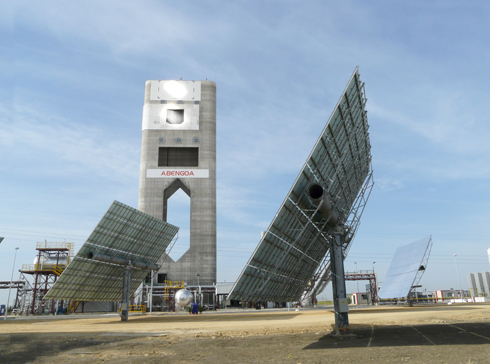
Torre Eureka
- Over the course of 2011, construction work continued on other central receiver plants (molten salt and pressurized air), the pilot versions of which will become operational in 2012.
- Also in 2011, improvements were made to the direct steam generation (DSG) plant, which also entered service towards the start of 2009.
- Validation of thermal storage: the ongoing operation of a molten salts demonstration plant since 2009 has provided invaluable experience in the use of this storage medium and has allowed the company to gauge the overall performance of this kind of storage.
As a result of this R&D&I activity, Abengoa has proprietary technology protected through patents. The company therefore holds priority rights over numerous significant and crucial inventions within the solar sector, which have led the company to seek a grand total of 107 domestic patents in different stages of concession.
Major milestones of 2011
The R&D program in the solar business unit rests on four main pillars:
Central receiver and tower technology
Abengoa centers its research on central receiver and tower technology and this is what sets it apart from its competitors.
One of the internationally recognized hallmarks of Abengoa is its use of tower and heliostat technologies in its quest for efficiency, particularly in the solar component of the plant.
In 2011, besides operating the Eureka plant to produce superheated steam, the company undertook research and development relating to one of the main components of a solar plant: the receiver.
The Eureka facility reaches higher temperatures to produce superheated steam, thus improving the overall efficiency of the steam cycle. The plant features 35 heliostats and a 50 m tower mounting the experimental superheating receiver. The approximate power of the plant is 3 MW thermal.
The CRS molten salt project (co-financed by the Spanish CDTI) involves the engineering and manufacture of a solar receiver tower prototype in which the heat transfer fluid is a mixture of molten salts.
In addition, the Solugás project (co-financed by the European Union’s Seventh Framework Programme), which got under way in 2008, aims to demonstrate the functioning of tower technology at higher temperatures, using air as the heat transfer fluid and a gas cycle instead of steam.
In both projects, considerable progress has been made in constructing the pilot facilities, which will enter service over the first half of 2012.
Also in 2011, Abengoa developed a new heliostat allowing the company to slash costs by nearly 20 % in addition to the cost reduction obtained in 2010.
Parabolic troughs
Parabolic-trough technology offers great potential for improvement in a wide range of its components, including structure, mirror fixing approaches, tubes and interconnections. Abengoa is researching all of these components. At its prototype facilities at the Solucar complex, the company tries out many different configurations in an ongoing search for an optimum ensuring the utmost efficiency at a competitive cost.
Since 2007, the company has operated an experimental loop comprising four collectors and using thermal oil as the heat transfer fluid. Potential optical and thermal improvements have been assessed and all the key components of the technology have now been identified.
The direct steam generation plant was also modified in 2011 to improve its operation, which was resumed four months ago. This plant comprises three loops and uses steam as its heat transfer fluid. By removing the need for an oil-steam exchanger, the technology boosts overall plant efficiency. Yet this direct generation technology requires a far more critical degree of control than thermal oil; the coexistence of two phases of matter in the receiver tube makes for higher instability.
We are also developing two new types of collector that use different materials so as to avoid commodity price risk.
Research is also continuing under the Cenit Consolida project to improve components and transfer fluids. Here, the sought-after qualities are maximum durability and minimum environmental impact.
Storage technologies
The electricity-generating at solar thermal plants is on his way to be sufficiently mature to be treated as a viable alternative to conventional thermal power plants. In order to get round the seasonal nature of solar radiation, thermal energy storage is a key factor.
The size of the energy storage system attached to a solar plant is determined by the plant’s main transfer fluid -steam or thermal oil. Vapor stores heat in latent form, while oil stores it in sensible form.
Parabolic trough plants use thermal oil, and thus thermal storage in the form of sensible heat. A hot body (e.g., a heat transfer fluid) is brought into contact with a cooler liquid, solid or gaseous medium in which the heat is to be stored. As a result, the storage medium heats up. Using the sensible heat of the material, the medium stores energy as and when its temperature rises.
This technology continued to undergo testing in 2011 at an experimental plant. The experience provided a highly valuable lesson in operation and optimization for the construction of future commercial solar plants with attached storage systems, such as the 280 MW Solana plant under construction at Phoenix, Arizona, where work got underway at the end of 2010.
Where heat is exchanged with a fluid that in that same process undergoes a change of phase -becoming steam- the storage technology makes use of the energy associated with the change of phase of the material or mix of materials. Abengoa is currently involved in various R&D projects within this particular area and for which we expect to see the corresponding pilot plants on the near horizon.
Furthermore, Abengoa has been involved in various projects to generate hydrogen from solar thermal and photovoltaic energy.
Photovoltaic technology
-
Concentrating photovoltaics (CPV)
In partnership with NREL and several North American universities and colleges, the company is developing new concentrating photovoltaic concepts, highlights include: a new generation of Fresnel lens photovoltaic concentrators, a semistatic low-concentrating system and other innovative technologies. In the mid-term, these new concepts are destined to play a key role in photovoltaic systems capable of generating electricity at competitive costs.
The company has been heavily involved in the development of solar trackers for concentrating photovoltaic applications. It successfully installed several CPV devices on a 400 kW plant at the ISFOC (Institute of Concentration Photovoltaic Systems) in Puertollano (Ciudad Real, Spain).
-
Technologies with new materials:
Abengoa is constructing an R&D technology center at Sanlucar la Mayor (Seville), where it intends to conduct research applied to new materials, photovoltaic cells, prototypes and photovoltaic thin-film technologies. The knowledge thus generated will lead to proprietary and competitive technologies in support of Abengoa’s future industrialization projects.
-
Photovoltaics laboratory:
The photovoltaics laboratory built in 2008 has tested and measured the performance of a wide range of photovoltaic systems under real operating conditions. Based on the data thus gathered, the laboratory has developed an experimental software application to analyze the cost of generating energy using different technologies and configurations, prevent or solve problems arising over the lifetime of photovoltaic systems, and identify the optimal technology and configuration for different kinds of facility.
Bioenergy
Abengoa intends to become a market leader in the biofuel sector while developing sustainable solutions for the transportation sector and creating bioproducts from biomass. The company focuses on the development of technologies for producing biofuel from lignocellulosic biomass, especially bioethanol via enzymatic hydrolysis and gasification and the catalytic synthesis of alcohols, and also on obtaining high value-added bioproducts.
The company has pilot facilities (0.4 ML/year) in York (Nebraska, US) and demonstration plants (5 ML/year) in Babilafuente (Salamanca, Spain), along with biochemical laboratories in Babilafuente and Seville and a laboratory with test bench plants at Seville University in order to test and improve catalysts. Abengoa is also developing the first production facility to produce second-generation ethanol commercially in Hugoton (Kansas), which will have an approximate capacity of 100 ML/year. The facility has already received significant development aid from the US Department of Energy.
In Europe, company business is part financed by aid received from the European Commission under its framework programs (Abengoa in the area of bioenergy ranks sixteenth in terms of support received under the VII Framework Programme), from various programs of the Spanish government and from different local bodies.
This support is a testament to the quality of the company’s research and development programs as it requires them to be assessed by third parties. The results obtained so far have been outstanding.
Major milestones of 2011
In the area of sustainability and energy consultancy, a highlight has been the design, development and subsequent approval from the European Commission for Abengoa’s own voluntary scheme (RBSA) through which to demonstrate compliance with the statutory requirements imposed by the Renewable Energy Directive 2008/29/EC. In addition, work continues on designing and improving sustainability management and strategic development systems and supporting interaction with stakeholders.
In the field of gasification and catalysis, in 2011 the company continued its ambitious program to develop heterogeneous catalysts for converting synthesis gas (syngas) into ethanol. The company has filed applications for two Spanish patents to protect groundbreaking catalysts that improve on existing start-of-the-art. We have continued to develop technical and economic models and analyses for various configurations of thermochemical biomass conversion, and to explore the different options for introducing biomass gasification technologies.
Our pilot plants are constantly evolving. We have introduced improvements to the starch-based production process so as to raise the performance of ethanol/grain conversion. At the same time, we are experimenting with new enzymes in order to assess the resulting improvements in performance and reduction of impacts. Major progress has thus been made in output performance as measured by liters of ethanol per ton of grain. Abengoa’s biofuels division has also been working on the development, assessment and validation of new processes to recover value from the coproducts of cereal-based bioethanol production, with special focus on improving coproduct consistency, enhancing protein digestibility and concentration, and developing pig and free-range poultry feed.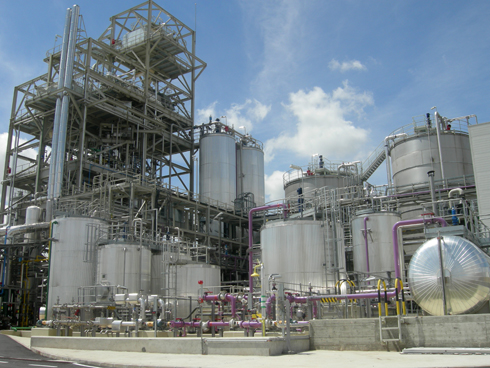
BCyL plant in Babilafuente (Salamanca).
A particular highlight for 2011 was the construction of an experimental plant in Cartagena, at which we intend to test various configurations of processes and technologies as part of an ambitious algae program, which includes isolation, characterization, development of laboratory-scale techniques to cultivate the algae and incorporate them into biofuels, and optimization of production systems to render them viable, culminating in the industrial integration of the resulting process. The experimental results obtained will be critical to proving once and for all that this technology can indeed produce new raw materials for biofuel plants and animal feed and, in synergy, capture of the fermentation CO2 generated during bioethanol production, thus allowing for further savings of greenhouse gas emissions within the transportation sector.
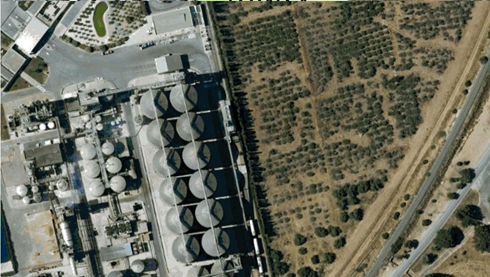
Experimental Ecoalga facility in Cartagena, Spain. The Ecoalga Project has received funding from the Spanish Ministry of Science and Innovation under the 2008- 2011 National Scientific Research, Development and Technological Innovation Plan. The plan is managed by the Spanish Institute of Oceanography under the Special State Fund for Stimulating the Economy and Employment, Plan E.
Moreover, Abengoa was deemed eligible to take part in the VII Framework Programme, heading proposals with a budget of over €10 M and thus helping to drive forward domestic and European SMEs and research centers. Abengoa has therefore improved on its position in the interim evaluation of the 7FP, in which it was ranked third within Spain for returns on 7FP funds, behind Telefónica and Atos Origin, and sixteenth on the European stage.
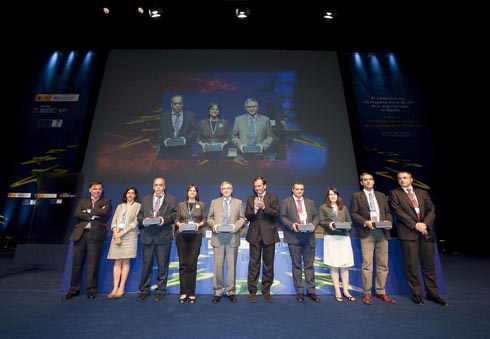
V Conference of the European Union’s VII Framework Programme for R&D in Spain, organized by the CDTI and the Sociedad para la Transformación Competitiva del Gobierno Vasco (SPRI) under the title “Towards a Common Research and Innovation Strategy”.
Enzymatic hydrolysis
Enzymatic hydrolysis technology is one of the key target areas for Abengoa is focusing its technological development efforts in order to diversify the range of raw materials from which biofuel and bioproducts can be produced. The main objective is to be able to produce bioethanol from raw lignocellulosic materials, chiefly straw from different cereal crops and herbaceous crops.
As a result of our work, we are now developing our own second generation proprietary technology at a pilot plant in York, Nebraska, coupled with our BCyL demonstration plant in Salamanca, Spain, which is the largest of its kind in the world producing this kind of second generation biofuel.
The BCyL demonstration plant has been operating non-stop for over 5,000 hours, delivering conversion performance figures above design specifications and illustrating its flexibility at utilizing different kinds of biomass.
The company is currently developing the Hugoton project (Kansas), where it intends to build its first commercial plant to produce 100 ML of bioethanol every year from sugar cane, wheat straw and switch grass (second generation bioethanol). These facilities will unquestionably be heralded as a milestone by the international community and thanks to its sterling work, Abengoa will have a technology that can be used worldwide. The company intends to grant licenses to third parties to improve the sustainability of the transportation sector.
Catalysis
As an alternative route to enzymatic hydrolysis technology, the company has also been busy working on biomass gasification and syngas conversion into ethanol through catalytic processes. In this particular field, Abengoa has been working to combine these technologies, and patents have been obtained for various catalysts and operating processes, making the company the leading figure in this technology.
Similarly, all the knowledge of catalytic processes gained from the development of ethanol synthesis technology is being channeled into other catalytic processes for converting ethanol into products with a greater value-added, such as butanol and jet fuel, and for transforming sugars directly via catalytic processes.
Enzymes
Abengoa has obtained a license from Dyadic to use and modify an organism that produces the enzymes required to convert cellulose into sugar. This represents a critical and essential step in developing enzymatic hydrolysis technology.
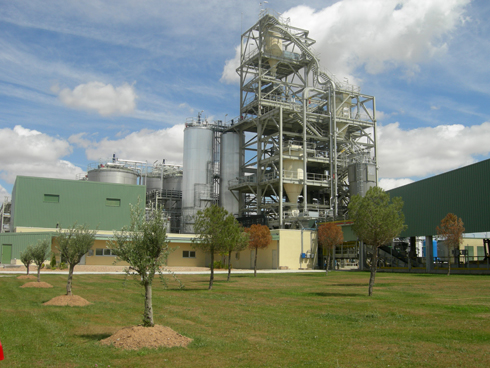
BCyL demonstration plant in Salamanca
Abengoa boasts a highly qualified team of engineers, chemists and biochemists, all of whom are working to develop this technology, focusing on aspects relating to the suitability of the organism to the production of the optimum enzymatic cocktail, and on the fermentation process needed to make this a reality on an industrial scale. The pilot facilities at York and the BCyL demonstration plant are essential for developing the enzymes and allow Abengoa to have a single base for testing worldwide.
Thanks to this technology, Abengoa has the product it needs for enzymatic hydrolysis technology, which it will use at its own plants and at third-party facilities that employ this same process for producing bioethanol
Bioproducts
Abengoa has a unique platform for producing sugar at its existing facilities and at the second-generation plants it is currently developing. One of the main objectives of this development program is to produce bioproducts through technologies in which we already have considerable experience (via fermentation), or through new processes that prove technologically competitive. The aim of this program is to increase the value-added of our plants through the new products we can obtain. We are confident that over the coming years these new products will provide a sustainable and economically competitive alternative to fossil fuels and will greatly reduce our dependence on oil derivatives.
The incorporation of bioproducts into the production output of our plants opens up a new field of applications with a number of different end-uses, where innovation is key to gaining a position of leadership in the use of the selected technologies.
Our prowess in R&D, both in terms of processes and biochemistry, demonstrates our ability to develop new technologies and provides a solid base from which to ensure the success of this program.
Algae
In 2009, Abengoa set in motion an ambitious algae program to isolate, characterize, select and improve organisms, develop laboratory-scale techniques for cultivating and processing these organisms in biofuel settings, optimize production systems so as to attain viability, develop post-cultivation processes of conversion into target products, and finally integrate the productive process with industrial activities.
Sustainability
Abengoa is developing specific technological solutions to trace our products from the raw material to the end user, enabling the company to label them, assess and verify their environmental benefits and ensure the global sustainability of producing them, with special emphasis placed on environmental concerns in the regions where the raw materials are produced. This process has led to a complete management system currently in place throughout the company and which could be licensed out to third parties.
The entire system is being incorporated into a single information and reporting platform, which encompasses management applications for raw materials and production, life cycle analysis calculations, GIS-based systems and information on processes. This platform will allow us to have a product that can be used to manage the sustainability of numerous different processes and will be of particular value for biofuels.
Desalination
Water is essential for ongoing life and is considered a right of every person on earth. Nevertheless, close to a third of the world’s population lives in countries that suffer from moderate to high water stress, while roughly 20 % has no reliable source of drinking water.
Only 3 % of the planet’s water is fresh water and only 0.3 % is available from rivers and 0.6 % from underground sources, with the rest tied up in the polar icecaps. As a result, most of the planet’s water is either seawater or otherwise difficult to access. In addition, humankind dump much of its waste into watercourses and coastal waters, leading to undesirable changes in their structure.
Water is therefore a scarce natural resource and we must learn to manage it sustainably and harmonize economic growth with water availability.
Description
At Abengoa, innovation applied to water treatment is geared towards creating value by developing new water treatment technologies that respect sustainable development.
With this in mind, the company has a strategic R&D&I plan in place specifically for water, which rests chiefly on four levers:
- Own resources, primarily our R&D&I department and R&D&I center.
- Research and development aid and subsidies from different bodies.
- Agreements with universities.
- Technological agreements.
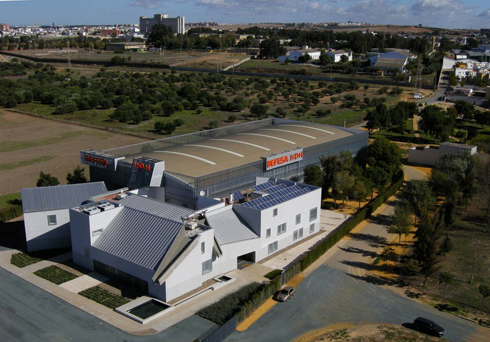
R&D center in Dos Hermanas (Seville)
The solution to water scarcity lies in the proper management of scarce resources, the generation of alternative water resources, and factoring in sustainability criteria for water treatment and use.
Abengoa’s commitment centers on developing desalination technology through
reverse osmosis, allowing us to render seawater and brackish water drinkable,
and on developing wastewater treatment and regeneration technologies, enabling us
to reuse the water and therefore generate new water resources in regions suffering from water stress.
The company also develops hollow-fiber filtration membrane technology using polymeric materials, which can be applied to both desalination processes and water treatment processes for potabilization, purification and regeneration.
Major milestones of 2011
R&D&I in the field of water treatment is divided into four programs: two vertical ones focused on developing water treatment processes, particularly Desalination and Potabilization – Purification - Reuse, respectively, a third horizontal program that aims to develop filtration membranes, and a fourth general program to seek out innovative solutions based on ensuring the sustainability of the water cycle.
Desalination
Abengoa is focused on enhancing the efficiency of the reverse osmosis (RO) process and on lowering associated investment and operation and maintenance costs.
Work tends to follow two lines: optimizing the RO desalination process on the one hand, and developing new desalination technologies on the other.
One of the most important aspects of desalination processes is the final remineralization stage, whereby the desalinated water is given the final properties it requires for its intended use. In this area, Abengoa has developed a new post-treatment system for remineralizing water desalinated through reverse osmosis. The system allows us to attain the desired quality in terms of the solid content of mineralized water, but with a 15 % saving in water consumption in comparison to the conventional systems currently found on the market.
Potabilization – Purification - Reuse
The aim here is to optimize membrane-based water treatment processes so as to save energy and produce less sludge, develop sludge treatment and elimination technologies and undertake research on supercritical oxidation.
As with desalination, work tends to focus on two lines. On the one hand, developing membrane-based wastewater treatment systems (including both urban and industrial water), thus allowing for water regeneration and subsequent reuse. On the other, developing advanced water treatment systems for removing emerging contaminants from both drinking and wastewater, and obtaining energy from water purification processes.
Abengoa has developed a wastewater treatment system based on pressure filtration with proprietary microfiltration membranes. The system has been tailored for two applications: Firstly, as a tertiary treatment for the regeneration and reuse of effluent from water purification plants and, secondly, to treat liquid effluent from industrial processes, including biofuel production, for subsequent reuse within the same process. In both cases, research has been conducted at pilot-scale.
Filtration membranes
The aim here is to develop proprietary hollow-fiber membrane micro- and ultrafiltration technologies, which can be applied to seawater or brackish water pretreatment processes; water filtration for potable use and urban and industrial wastewater purification for regeneration and reuse.
Work tends to focus on two lines: On the one hand, developing proprietary hollow-fiber polymeric membrane technology for both micro- and ultrafiltration and, on the other, gaining knowledge of membrane-based water filtration processes through an approach that includes not only theory but also experiments.
Abengoa has conducted in-depth analyses of the behavior of membrane filtration systems for water pretreatment for desalination. The company has carried out in-situ experiments to explore seawater filtration through micro- and ultrafiltration membranes, using outside-in and inside-out pressure filter systems under different operating conditions and for different membrane cleaning and regeneration strategies. These experiments are conducted in China.
Sustainability program
The purpose of this program is to develop and apply sustainability criteria when designing solutions, incorporating renewable energy sources (solar, wind, marine) into desalination processes, and conducting life cycle assessments (LCA) of the different water treatment processes.
Work has focused primarily on two lines: applying solar power to desalination and the LCA of desalination, potabilization and purification processes.
Wok has continued on the construction and commissioning of a solar thermal powered demonstration desalination facility. The system involves a multi-effect desalination process (MED) powered by the thermal energy collected by a field of parabolic troughs. In order to render it more efficient, the system features a double-effect absorption pump.
Ocean energy
In 2011, Abengoa decided to drive forward its sea power business by creating a new business line.
There are two key factors underpinning the success of this new activity: firstly, the company’s impressive track record in developing turnkey renewable energy projects and secondly, access to state-of-the-art technology specific to this field. In addition to the knowledge that Abengoa’s own R&D team has built up over years of research (track record), the company also strikes up strategic alliances with specialized technology firms to offer solutions for different kinds of plant (access to cutting-edge technology).
Description
This line of business draws together all the different offshore renewable energy generation activities, including wave power, marine current power and, of course, offshore wind power. Our multi-disciplinary team is made up of engineers and scientists with differing fields of expertise; a core team of workers that will grow as needed, given the unique problems associated with working in marine environments.
This reflects the global strategy of Abengoa and its commitment to developing innovative solutions in the realm of sustainability. Although this kind of technology is currently less mature than solar or wind power, it promises much for the future.
In addition to the company’s own projects, the ocean energy business line is involved in R&D ventures through Spanish and European consortiums, including:
Unique Strategic Ocean Energy Project (PSE-Mar)
Electromechanical design of specific underwater connectors for wave power devices.
Cenit TEcoAgua project: “Sustainable Technologies for the Integral Water Cycle”
Managing knowledge, processes and technologies for the integral water cycle.
ORECCA project: “Offshore Renewable Energy Conversion Platforms – Coordinated Action”
Research aimed at developing future marine platforms to generate energy from wind
and marine resources in tandem.
SOWFIA project: “Streamlining of Ocean Wave Farms Impact Assessment”
Assessment of the environmental and socio-economic impact of ocean wave farms.
In addition to the R&D&I projects, Abengoa’s ocean energy business line is actively involved in the following forums and platforms for promoting and driving forward innovation and the development of emerging technologies:
- WTE – Aenor’s National Standardization Committee AEN/CTN 206/SC 114 on ocean energy (Vice-Presidency)
- WTE – Forum on the Marine Energy of the Spanish Maritime Technology Platform
- WTE – Marine Energy Group of the Spanish Maritime Cluster
Hydrogen
Abengoa develops proprietary technology in the hydrogen sector, as an energy vector, and in fuel cells, as a gas means of use; in both cases, the company protects its know-how through patents, agreements and alliances.
To elaborate further, the company organizes and conducts business to produce electrical and thermal power through fuel cells (using the different technologies involved) and to generate hydrogen from renewable sources and clean and efficient hydrogen use (including transportation and storage).
Major milestones of 2011
Highlight research and development activities within the hydrogen sector in 2011 include the following:
- Development of hydrogen storage systems based on hydrosilanes and aminoboranes and start-up of a borohydride-based system to power fuel cells. The aim is to create more secure and efficient systems (greater energy density in terms of volume and weight) for transporting the gas so that these systems can be integrated into different kinds of applications.
- Detail engineering of a solar reactor for hydrogen production through bioethanol reforming. This reactor employs catalysts and solar thermal energy to attain a current of hydrogen-rich gas from a mixture of ethanol and steam.
- Detail engineering of a solar reactor for water-to-hydrogen production through thermochemical cycles. In this case, only water is used as the raw material for producing hydrogen; nonetheless, to reduce the temperature needed to disassociate the hydrogen molecules, thermochemical cycles are used instead of direct thermolysis.
- Completion of studies for the use of fuel cell systems in different railroad applications. Abengoa has cooperated with manufacturers from the railroad sector in pursuit of more sustainable forms of rail transport that utilize hydrogen as the energy vector, analyzing both vehicle propulsion systems and the supply of auxiliary parts.
- Development of new portable systems for generating electrical power from fuel cells, including testing of these systems. Along these lines, Abengoa has been operating 20-50 W systems powered with polymer fuel cells (polymer electrolyte membrane, or PEM), integrating all the necessary elements to ensure they work properly, including hydrogen storage.
- Generation of electrical power via hydrogen combustion: analysis of alternative internal combustion engines, turbines and microturbines. This line of research, which was initiated only recently, aims to harness hydrogen in order to generate thermal, mechanical and electrical power under different engine and turbine set-ups for use in the stationary and transportation sectors.
- Application of fuel cell systems for powering robots. Abengoa has been collaborating with Rey Juan Carlos University to develop a power system for androids, employing hydrogen as the fuel source and polymer fuel cells. Development of new portable systems for generating electrical power from fuel cells, including testing of these systems.
- Study and analysis of the hydrogen life cycle. This covers the entire hydrogen production chain and use of the gas in fuel cells, factoring in the environmental concerns (chiefly CO2 emissions) and economic considerations (associated costs) of the different processes for producing the gas.
With a view to optimizing its R&D activity, Abengoa has set up a Laboratory for Trials and Characterization of Fuel Cells and Advanced Hydrogen Technologies at its Campus Palmas Altas headquarters in Seville. The laboratory was designed by the company’s technical team and features different technologies for producing hydrogen (reforming, electrolysis), conventional and experimental storage systems, and an area for testing fuel cells and developing their associated subsystems (particularly power electronics and control systems).
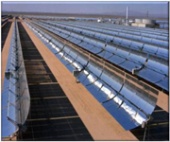
Parabolic trough
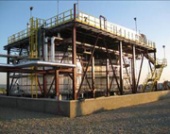
TES
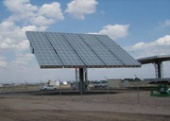
Concentrating photovoltaics
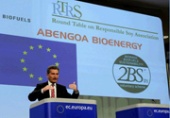
The European Commissioner for Energy, Günther Oettinger, pictured here on July 19, 2011 while recognizing Abengoa’s own voluntary RBSA scheme as one of the seven approved schemes for demonstrating compliance with the sustainability requirements enshrined in the European Energy Directive 2009/28/EC
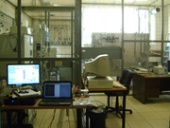
Biofuel synthesis laboratory

Ocean energy
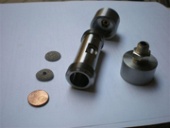
Hydrogen borohydrides

Hydrogen-powered android
© 2011 Abengoa. All rights reserved
